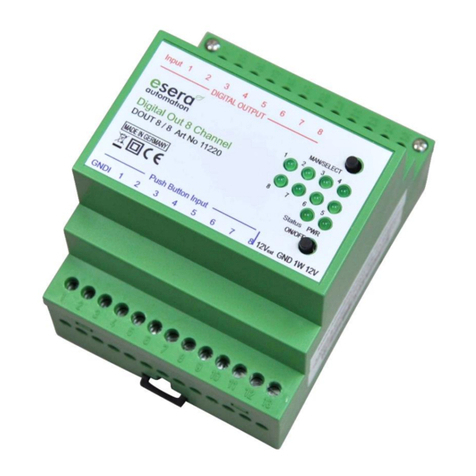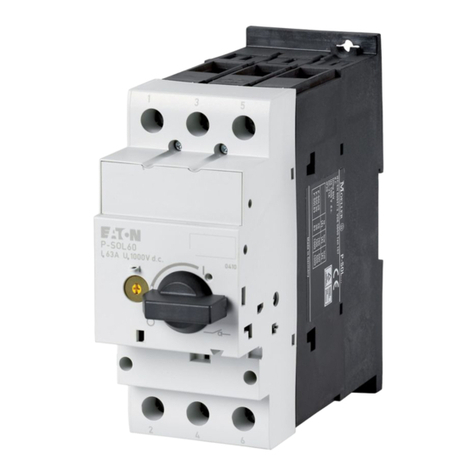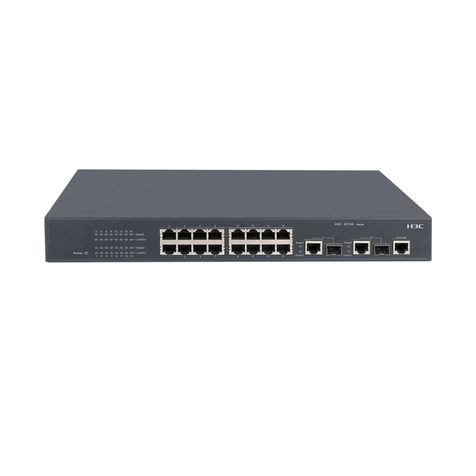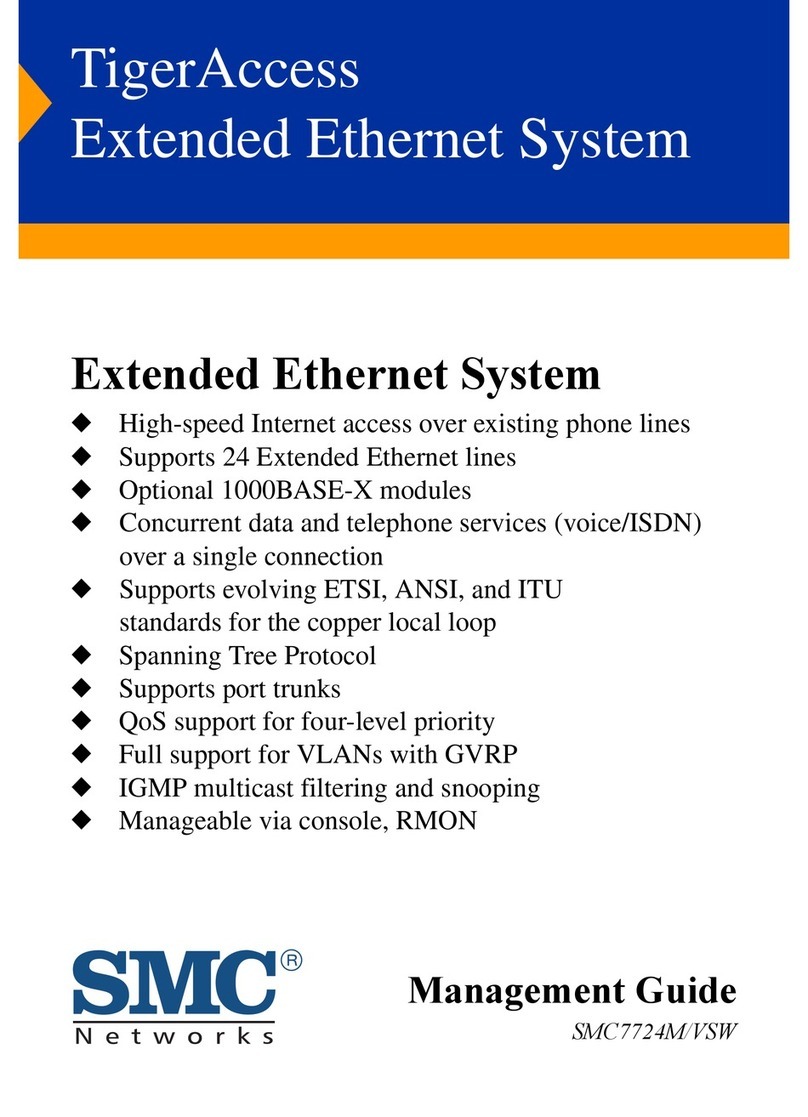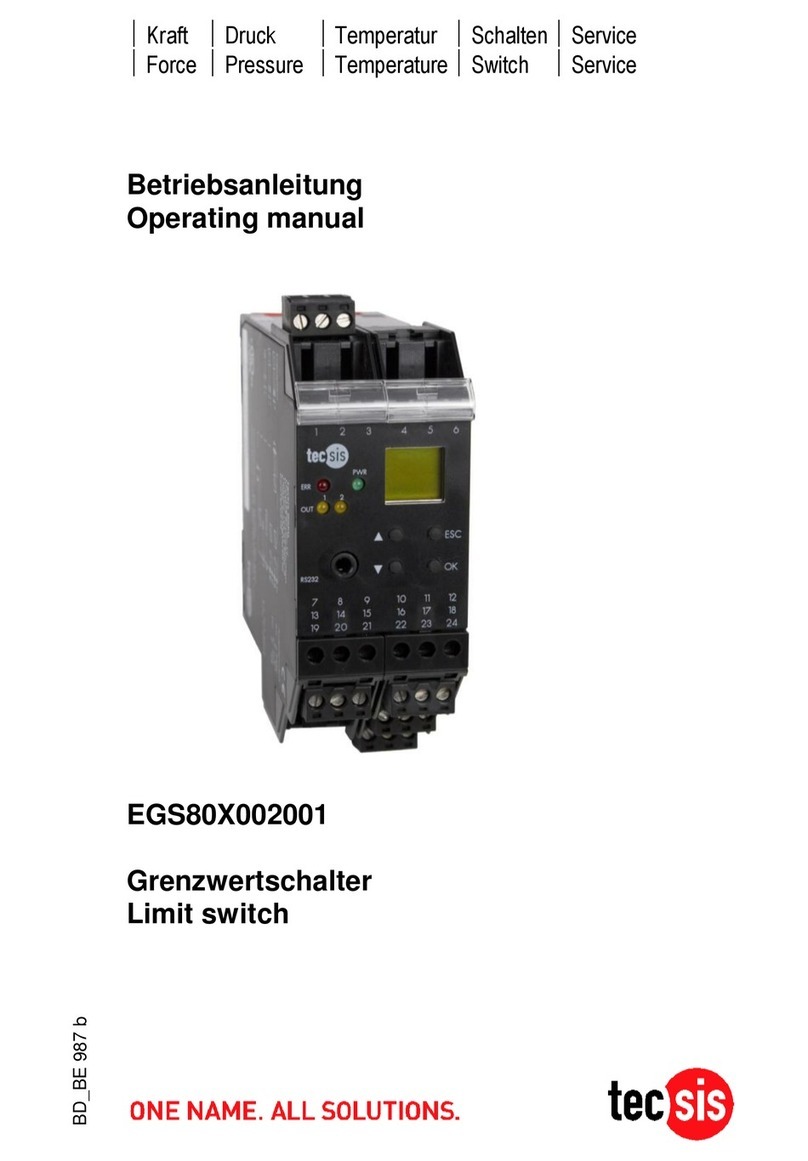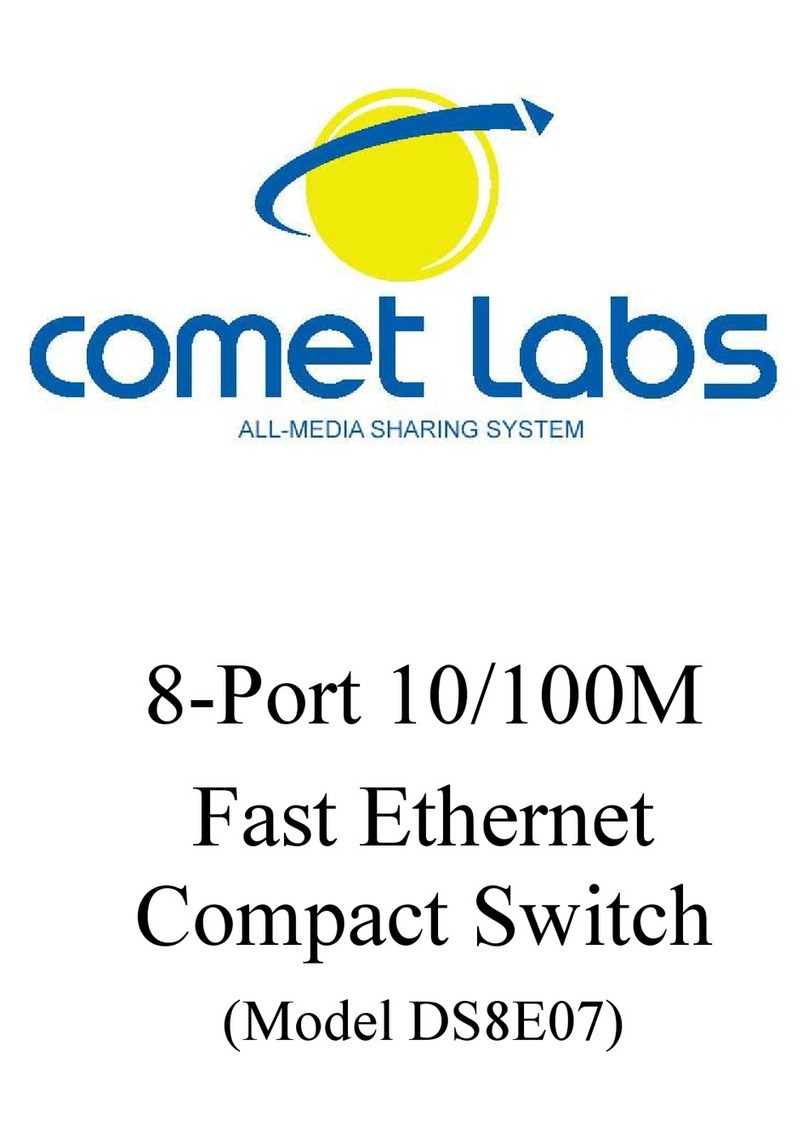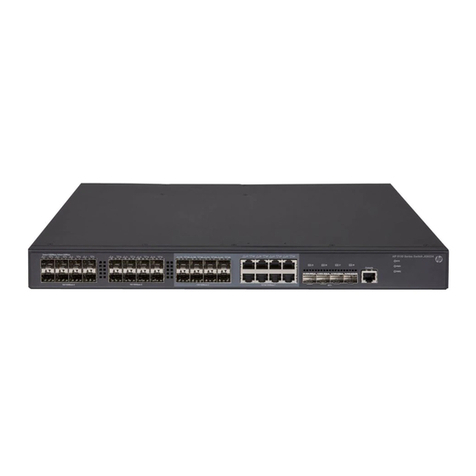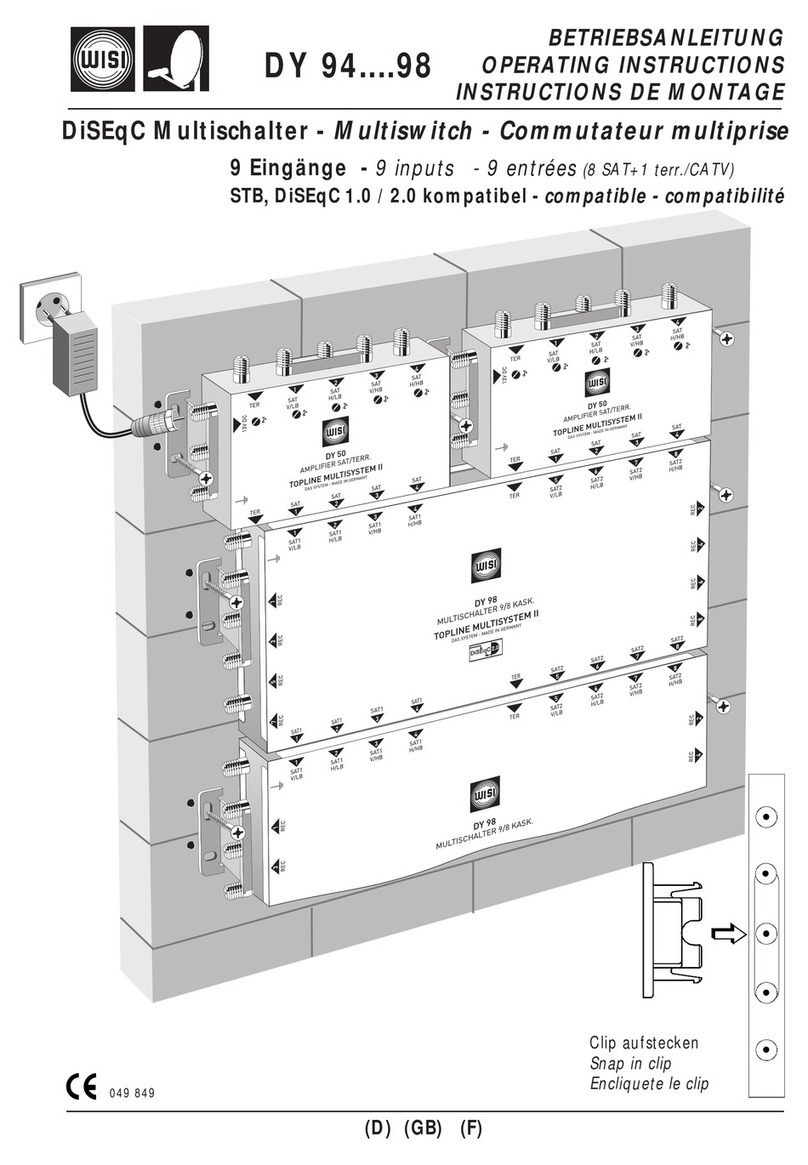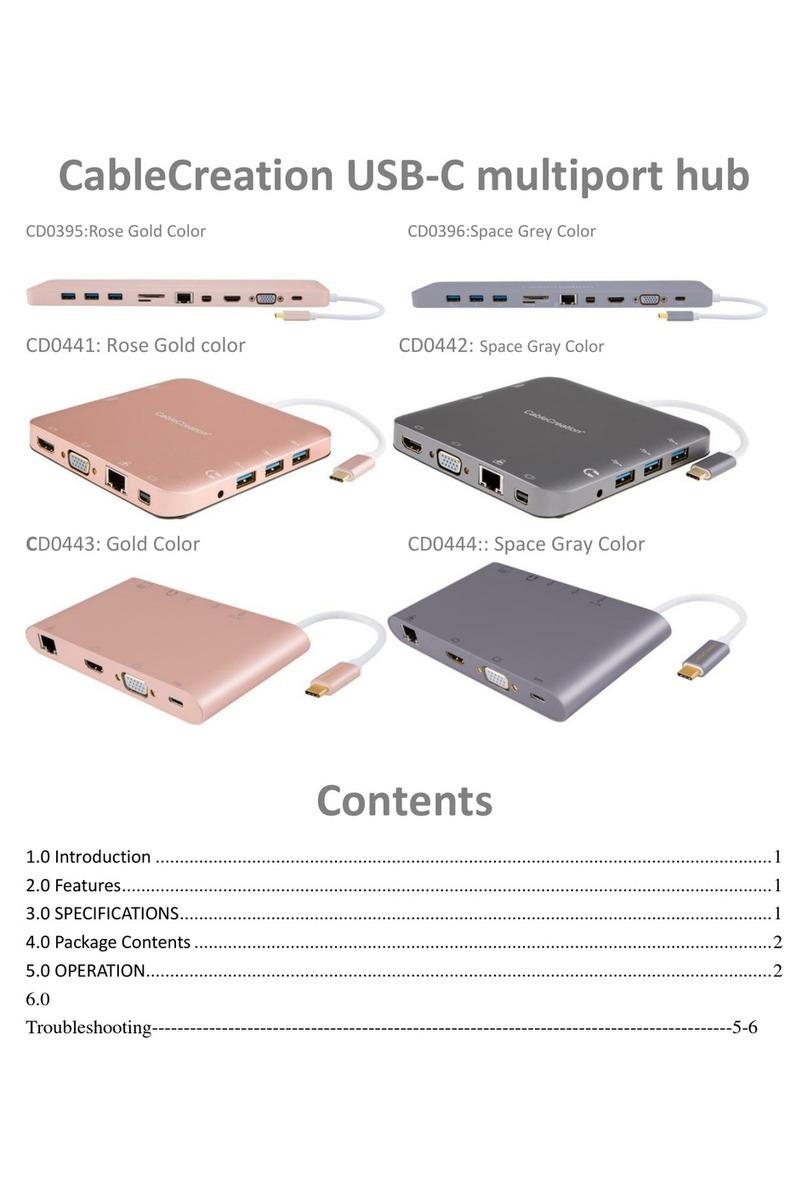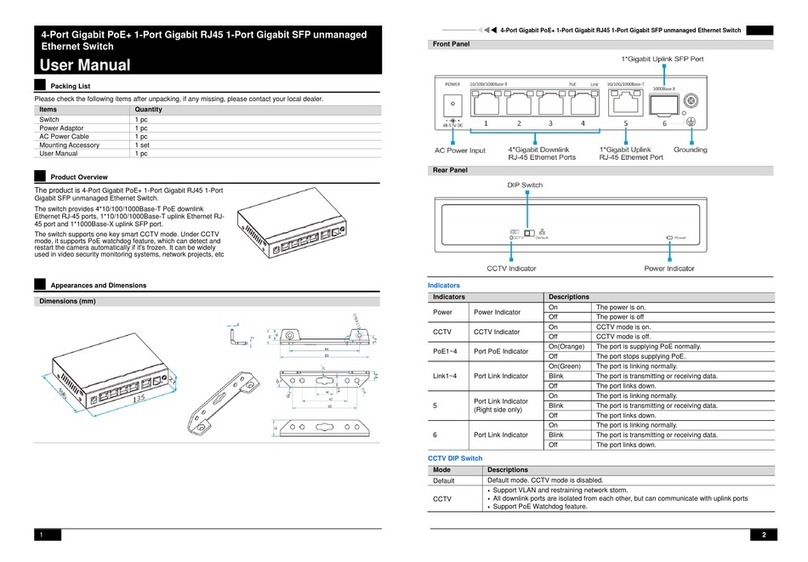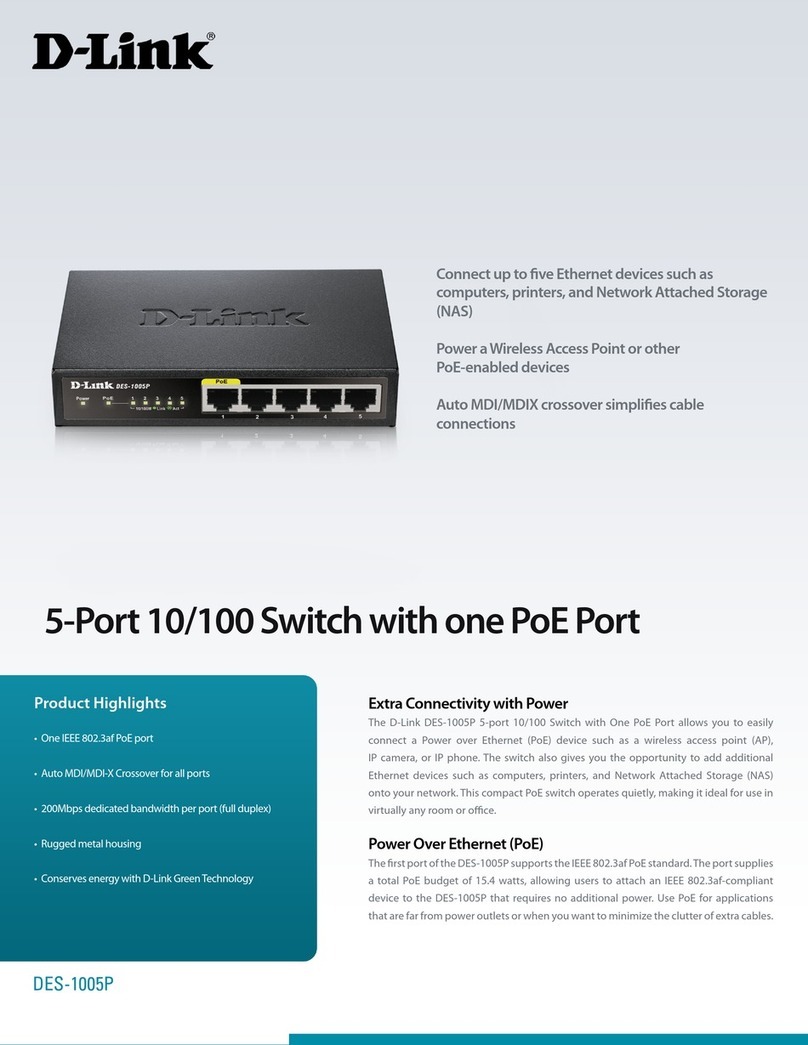esera automation 11220 User manual

Art. No. 11220
All rights reserved. Reproduction as well as electronic duplication of this user guide, complete or in part, requires the written consent of
ESERA GmbH. Errors and technical modification subject to change. ESERA GmbH, ESERA-Automation 2020
www.esera.de 11220 V2.0 R1.0 Manual Page 1 of 7
User Guide
8-fold Switch Module with Pushbutton inputs
for 1-Wire Bus
8 power relays with 8A continuous power
Control inputs for button and 1-Wire Bus
LED display for activated relays
Switching of DC or AC consumers, such as
lighting, heating or sockets
Top-hat rail housing for control cabinet
installation
Easy software-based control
Low space requirement in the control
cabinet
Easy to assemble
1 Introduction
Before you start assembling the Switch Module and put the device into operation, please read this assembly and
operating instructions carefully to the end, especially the section referring to the safety notes.
2 Product description
With the 8-fold switching module direct and alternating current consumers with a current of up to 8A continuous
current per channel and a total of 10A can be switched.
The 8-fold switching module can be controlled directly by an external push button (e.g. light switch) or by a push
button menu on the top of the module, also independently of the 1-Wire interface. For this switching function by
push button it is sufficient if the 12V supply voltage is applied. This ensures an extremely high reliability, e.g. for
switching lights, socket circuits or other important consumers, even if a central control unit / software fails.
The relays switched via the push button interface or by manual operation can be read back via the 1 Wire interface.
Also the status of the push button interface can be read back.
To supply the switch module we recommend the use of one of our 1-Wire Hub modules.

All rights reserved. Reproduction as well as electronic duplication of this user guide, complete or in part, requires the written consent of
ESERA GmbH. Errors and technical modification subject to change. ESERA GmbH, ESERA-Automation 2020
www.esera.de 11220 V2.0 R1.0 Manual Page 2 of 7
3 Auto-E-Connect® Support
The ESERA Auto-E-Connect® 1-Wire Plug and Play system will be used for the
1-Wire Bus supported. This enables fully automatic configurations of 1-Wire sensors
and actuators on the 1-Wire bus. It is optimized for industrial applications and
enables significant added value beyond the sensor and chip data.
The Auto-E-Connect function automatically recognizes ESERA chips, sensors and actuators, starts suitable
libraries and outputs fully formatted data.
The Auto-E-Connect functionality will be available from mid 2020 via 1-Wire Controllers, 1-Wire Gateways and
1-Wire ECO from ESERA available.
Further information on ESERA Auto-E-Connect can be found on the ESERA website, ESERA Config-Tool 3, or in
the download area for this article in the ESERA Webshop.
4 Technical data
Switching channels: 8, normally open contact Relay (NO contact)
Switching voltage: Max. 250V DC or AC voltage
Switching current/Power :Max. 8A continuous current per output and maximally 1840VA continuous power at
resistive load. Minimum load 10mA
Maximum 10A current in sum for all outputs
For capacitive or inductive loads, appropriate additional circuits, such as spark
quenching capacitors, must be provided. The max. current and power are reduced with
non-resistive loads.
Fuses: External back-up fuse with 10A recommended
Data interface: 1-Wire Bus (12V, data and load)
Interface: 1-Wire DS2408 command set
Operating voltage: 12VDC (+/-10 %)
Power consumption12V: Idle state, no output relay active: ca 10mA
All outputs active: ca 160mA
Pushbutton interface: 8 digital- /binary inputs, pulse input e.g. for pushbutton switch (closing contact)
Pulse duration min. 40ms
Input voltage 10-30VDC, max. 10mA per input, common ground.
Inputs isolated from 1-Wire interface and power supply.
The cable length between module and button is not critical, but should not exceed 30m.
Connection: Screw terminals (up to 2,5qmm wire cross section)
5 Ambient conditions:
Temperature, operation: 0 °C up to +50 °C
Air humidity: 10 –92 % (non-condensing)
Dimensions: 70 x 90 x 70mm (WxHxD)
Protection class: II
Protection type: IP20
Insulation strength: 500VAC output to 1-Wire Bus, 250VAC output to output

Art. No. 11220
All rights reserved. Reproduction as well as electronic duplication of this user guide, complete or in part, requires the written consent of
ESERA GmbH. Errors and technical modification subject to change. ESERA GmbH, ESERA-Automation 2020
www.esera.de 11220 V2.0 R1.0 Manual Page 3 of 7
6 Connection plan
The connection plan is available in the shop as an own document.
Notice: A 10A preliminary fuse is required in front of screw terminal 14.
Connection top side: (normally open)
15 = Relay Output 1
16 = Relay Output 2
17 = Relay Output 3
18 = Relay Output 4
19 = Relay Output 5
20 = Relay Output 6
21 = Relay Output 7
22 = Relay Output 8
Module bottom side:
Button input, 10-30V
1 = GND (ground) button input
2 = Button 1
3 = Button 2
4 = Button 3
5 = Button 4
6 = Button 5
7 = Button 6
8 = Button 7
9 = Button 8
7 Conformity
EN 50090-2-2,
EN 61000-4-2, ESD
EN 61000-4-3, HF
EN 61000-4-4, Burst
EN 61000-4-5, Surge
EN 61000-6-1, Fault-free operation
EN 61000-6-3, Stray radiations
RoHS
1-Wire Bus
10 = +12V external voltage (optional)
11 = GND (ground)
12 = 1-Wire data line
13 = +12V voltage

All rights reserved. Reproduction as well as electronic duplication of this user guide, complete or in part, requires the written consent of
ESERA GmbH. Errors and technical modification subject to change. ESERA GmbH, ESERA-Automation 2020
www.esera.de 11220 V2.0 R1.0 Manual Page 4 of 7
8 Operating mode, display and operation
The module has two modes of operation: normal mode and manual control mode.
Normal mode: After start-up, the device is in normal operation mode. This means that a command is applied
directly by the 1-Wire interface to the appropriate output relay. The respective output LED is lit.
Manual control mode: By pressing the button „MAN/Select“ for 2 seconds, the module switches to manual
control mode (manual operation). The „PWR“ LED flashes to confirm selection of manual control mode.
Press the "MAN / Select" key briefly to select an output. The LEDs 1-8 light up for the selected output. Press the
"ON / OFF" key to switch the selected output on or off.
Several outputs can be switched in one cycle.
After a waiting time of approx. 2 seconds, the system automatically switches to the operating mode "normal
operation", the "PWR" LED lights up again permanently and the selected outputs are activated.
Delete "Manual operation": Pressing the "ON/OFF" key for 2 seconds switches off the outputs selected in
manual operation.
Display
Designation
LED function
LED 1-8
Output 1-8
- LED is lit for 2 seconds on system start-up
- Normal mode: LED display is lit when the output is active
- Manual control mode: Select the output to be switched on or off
with the „Select“ button
LED PWR
Power
- LED flashes 2 seconds to start the system
- LED is lit when an output relay is active
- LED flashes in the manual control mode
LED Status
Status display
manual control
mode
- LED is lit for 2 seconds on system start-up
- Status display of the selected output after switch to normal mode
operation (relay on or off)
Button
Designation
Button function
MAN/Select
Operating mode /
Channel selection
The button has two different functions
- Switch to manual control mode (press for 2 seconds)
- Select output (press briefly)
ON/OFF
Output 2 On/Off
The button has two different functions
- Selected output On / Off (press briefly)
- Delete all outputs of manual control mode (press for 2 seconds)
9 8-fold digital input, pushbutton Interface
In addition to the manual mode (module top side), and the 1-Wire interface, the module also has
8-fold pushbutton interface, 8 x digital / binary input, for switching the outputs.
To switch an output, a short input signal (keystroke) to the corresponding input is sufficient.
The 8-fold pushbutton interface is intended for switching lights, actuators for radiators or sockets in the living area
by e.g. light switches or motion detectors with pulse output. This ensures fast switching even with no system
control available.
The impulse control, comparable to a staircase lighting timer, allows any number of light sensors and motion
detectors to be connected at the same time.
Further details on the ESERA-Automation lighting system can be found on the following website:
https://www.esera.de/smart-home/anwendungsbeispiele/lichtsteuerung/
Besides light scanners, any other pulse control signal can be used to switch the outputs.
All three interfaces, manual operation, 1-Wire and push button interface, operate in parallel to the outputs. An
output switched e.g. by the 1-Wire interface can be switched off or on manually or by push button interface.
The pushbutton interface can be used for example to connect light scanners for light on/off control. Normal light
scanners of all switch manufacturers can be used for this purpose.
Within the module a µController takes over the query of the buttons, the 1-Wire interface and the control of the
relays. The button interface is queried via edge scanning.
The outputs switched via the pushbutton interface or manual operation can be read back via the 1-Wire interface.

Art. No. 11220
All rights reserved. Reproduction as well as electronic duplication of this user guide, complete or in part, requires the written consent of
ESERA GmbH. Errors and technical modification subject to change. ESERA GmbH, ESERA-Automation 2020
www.esera.de 11220 V2.0 R1.0 Manual Page 5 of 7
10 Software / Control
The 1-Wire interface of the 8-fold digital output 8/8 is controlled by standard commands for the DS2408 module.
The outputs switched via the pushbutton interface or manual operation can be controlled via the
1-Wire interface can be read back.
11 Control by 1-Wire Controller / 1-Wire Gateway
The 1-Wire interface of the 8-fold digital output 8/8 is controlled by standard commands for the DS2408 device.
The outputs switched via the pushbutton interface or the manual mode can be read back via the 1-Wire interface.
The 8-fold switching module can be controlled very easily via a 1-Wire controller / 1-Wire gateway. Two
commands are available for this purpose. Below are the two commands.
11.1 Switching an output relay
To switch a relay output, use the following command, which only sets the selected output to 0 or 1.
Command: SET,OWD,OUT,OWD-Number,Output,Value
Example: set,owd,out,2,1,1 => OWD Number 2, output 2 will be switched to “on”.
After switching the output latest status will be output as confirmation.
11.2 Switching of all output relays (Port)
There are applications and modules where it is necessary to switch all outputs with one command.
With one command, all outputs of the 1-Wire module are set to a specific state, which means that the previous
output state is overwritten.
The 1-Wire Controller / the 1-Wire Gateway takes over the command adaptation to the connected
Module 8-fold switching module.
The output value is output as decimal value 0-254. Each relay output has a valence which is summed up.
Output 1 = 1, Output 2 = 2, Output 3 = 4, Output 4 = 8, Output 5 = 16, Output 6 = 32,
Output 7 = 64, Output 8 = 128.
For example, if you want to switch Output 1, 3 and 5 to 1, add the output value together.
Here e.g. 1 + 4 + 16 = 21
All other relay outputs are switched to 0. If all outputs are to be switched to 0 or off, the output value is 0.
Permissible output values for 1-Wire digital outputs: 0 - 255
Command: SET,OWD,OUTH,OWD-Number, value
Example: set,owd,outh,2,15 => OWD Number 2, outputs 1 to 4 will be switched to “on”.
After switching the output, latest status will be output as confirmation.
11.3 Data Output 1-Wire Controller / 1-Wire Gateway
For the 8-fold digital output 8/8, the following data is output for the binary / digital inputs (button interface) and
relay outputs.
The input and output values are output as decimal value 0-254 and in a second data set binary with 0 and 1.
Each input and output has a valence, which is added up in each case.
Input pushbutton interface:
Input 1 = 1, Input 2 = 2, Input 3 = 4, Input 4 = 8, Input 5 = 16, Input 6 = 32, Input 7 = 64,
Input 8 = 128.
Relay Output:
Output 1 = 1, Output 2 = 2, Output 3 = 4, Output 4 = 8, Output 5 = 16, Output 6 = 32, Output 7 = 64,
Output 8 = 128.

All rights reserved. Reproduction as well as electronic duplication of this user guide, complete or in part, requires the written consent of
ESERA GmbH. Errors and technical modification subject to change. ESERA GmbH, ESERA-Automation 2020
www.esera.de 11220 V2.0 R1.0 Manual Page 6 of 7
Data Output:
1_OWD1_1|8 => controller no._module no._data set | input decimal value
1_OWD1_2|10000000 => controller no._module no._data set | input binary display
1_OWD1_3|3 => controller no._module no._data set | output decimal value
1_OWD1_4|00000111 => controller no._module no._data set | output binary display
Further information regarding options and commands can be found in the latest available documentation for
1–Wire Controller / 1–Wire Gateway.
12 Operating conditions
The module may only be operated at the voltages and ambient conditions specified for it. The device can be
operated in any position. The device is intended for use in dry and dust-free rooms.
If condensation forms, wait at least 2 hours for the device to acclimatize.
Assemblies and components must not be handled by children!
The modules may only be put into operation under the supervision of a qualified electrician.
In commercial facilities the accident prevention regulations of the association of the commercial trade
associations for electrical systems and equipment must be observed.
Do not operate the module in an environment where flammable gases, vapors or dusts are present or could be
present.
13 Assembly
The installation site must be protected against moisture. The device may only be used in dry indoor rooms and in
protected outdoor areas. The device is intended for mounting inside a switch cabinet as a stationary
device.
14 Disposal Note
Do not dispose of this device in the household waste. Electronic devices must be disposed in
accordance with directives for disposing of waste electrical and electronic equipment at local
collection points for electronic waste material.
15 Safety instructions
When using products that come into contact with electrical voltage, the valid VDE regulations must be
observed, especially VDE 0100, VDE 0550/0551, VDE 0700, VDE 0711 and VDE 0860
During final works and wiring works power has to be de-connected.
Before opening the device, always unplug and make sure that the unit is disconnected from the mains.
Components, modules or devices may only be put into service if they are mounted in a contact proof housing. During
installation they must not have power applied.
Tools may only be used on devices, components or assemblies when it is certain that the devices are disconnected
from the power supply and electrical charges stored in the components inside the device have been discharged.
Live cables or wires to which the device or an assembly is connected, must always be tested for insulation faults or
breaks.
If an error is detected in the supply line, the device must be immediately taken out of operation until the faulty cable
has been replaced.
When using components or modules it is absolutely necessary to comply with the requirements set out in the
accompanying description specifications for electrical quantities.
If the available description is not clear to the non-commercial end-user what the applicable electrical characteristics for
a part or assembly are, how to connect an external circuit, which external components or additional devices can be
connected or which values these external components may have, a qualified electrician must be consulted.
It must be examined generally before the commissioning of a device, whether this device or module is basically
suitable for the application in which it is to be used.
In case of doubt, consultation with experts or the manufacturer of the components used is absolutely necessary.
For operational and connection errors outside of our control, we assume no liability of any kind for any resulting
damage.
Kits should be returned without their housing when not functional with an exact error description and the
accompanying instructions. Without an error description it is not possible to repair the device. For time-consuming
assembly or disassembly of cases charges will be invoiced.
During installation and handling of components which later have mains potential on their parts, the relevant VDE
regulations must be observed.
Devices that are to be operated at a voltage greater than 35 VDC / 12mA, may only be connected by a qualified
electrician and put into operation.
Commissioning may only be realized if the circuit is built into a contact proof housing.
If measurements with an open housing are unavoidable, for safety reasons an isolating transformer must be installed
upstream or a suitable power supply can be used.
After installing the required tests according to DGUV / regulation 3 (German statutory accident insurance,
https://en.wikipedia.org/wiki/German_Statutory_Accident_Insurance) must be carried out.

Art. No. 11220
All rights reserved. Reproduction as well as electronic duplication of this user guide, complete or in part, requires the written consent of
ESERA GmbH. Errors and technical modification subject to change. ESERA GmbH, ESERA-Automation 2020
www.esera.de 11220 V2.0 R1.0 Manual Page 7 of 7
16 Warranty
ESERA GmbH guarantees that the goods sold at the time of transfer of risk to be free from material and workmanship defects
and have the contractually assured characteristics. The statutory warranty period of two years begins from date of invoice.
The warranty does not extend to the normal operational wear and normal wear and tear. Customer claims for damages, for
example, for non-performance, fault in contracting, breach of secondary contractual obligations, consequential damages,
damages resulting from unauthorized usage and other legal grounds are excluded. Excepting to this, ESERA GmbH accepts
liability for the absence of a guaranteed quality resulting from intent or gross negligence. Claims made under the Product
Liability Act are not affected.
If defects occur for which the ESERA GmbH is responsible, and in the case of replacement goods, the replacement is faulty,
the buyer has the right to have the original purchase price refunded or a reduction of the purchase price.
ESERA GmbH accepts liability neither for the constant and uninterrupted availability of the ESERA GmbH or for technical or
electronic errors in the online offer.
We are constantly developing our products further and reserve the right to make changes and improvements to any of the
products described in this documentation without prior notice. Should you require documents or information on older
17 Trademarks
All mentioned designations, logos, names and trademarks (including those which are not explicitly marked) are trademarks,
registered trademarks or other copyright or trademarks or titles or legally protected designations of their respective owners
and are hereby expressly recognized as such by us. The mention of these designations, logos, names and trademarks is
made for identification purposes only and does not represent a claim of any kind on the part of ESERA GmbH on these
designations, logos, names and trademarks. Moreover, from their appearance on ESERA GmbH webpages it cannot be
concluded that designations, logos, names and trademarks are free of commercial property rights.
ESERA and Auto-E-Connect are registered trademarks of ESERA GmbH.
18 Contact
ESERA GmbH
Adelindastrasse 20
87600 Kaufbeuren
GERMANY
Tel.: +49 8341 999 80-0
Fax: +49 8341 999 80-10
www.esera.de
WEEE-Number: DE30249510
This manual suits for next models
1
Table of contents
Other esera automation Switch manuals
Popular Switch manuals by other brands
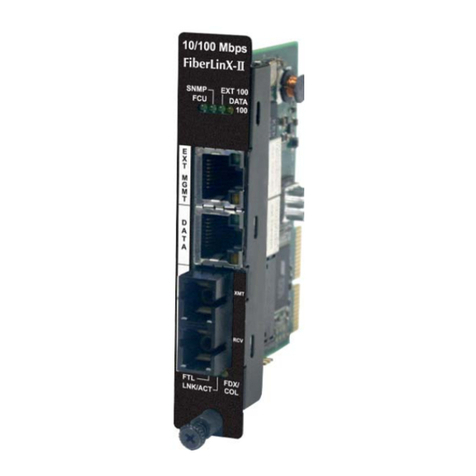
IMC Networks
IMC Networks iMcV-FiberLinX-II Operation manual
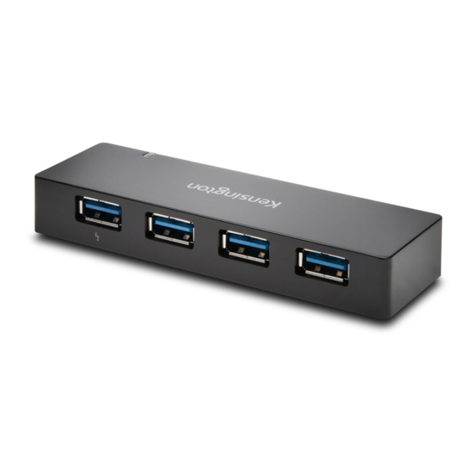
Kensington
Kensington DEMCO UH4000C quick start guide
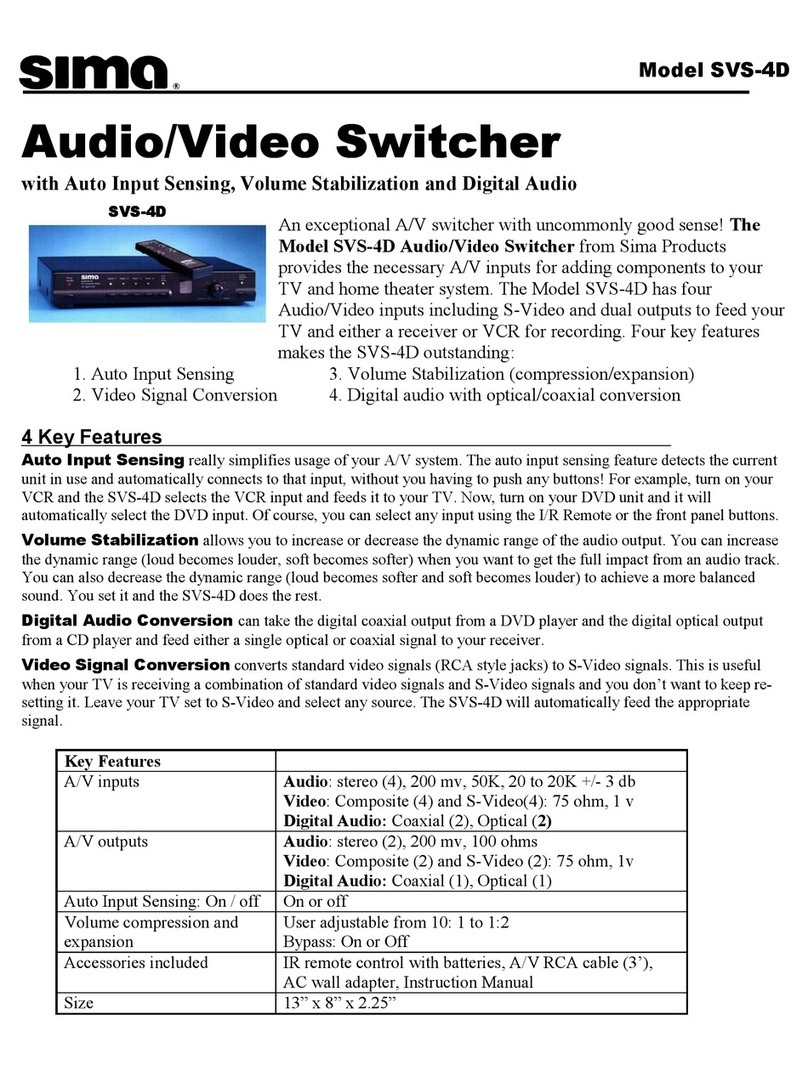
Sima
Sima SVS-4D Specifications

Dell
Dell Force10 Z9000 Configuration guide
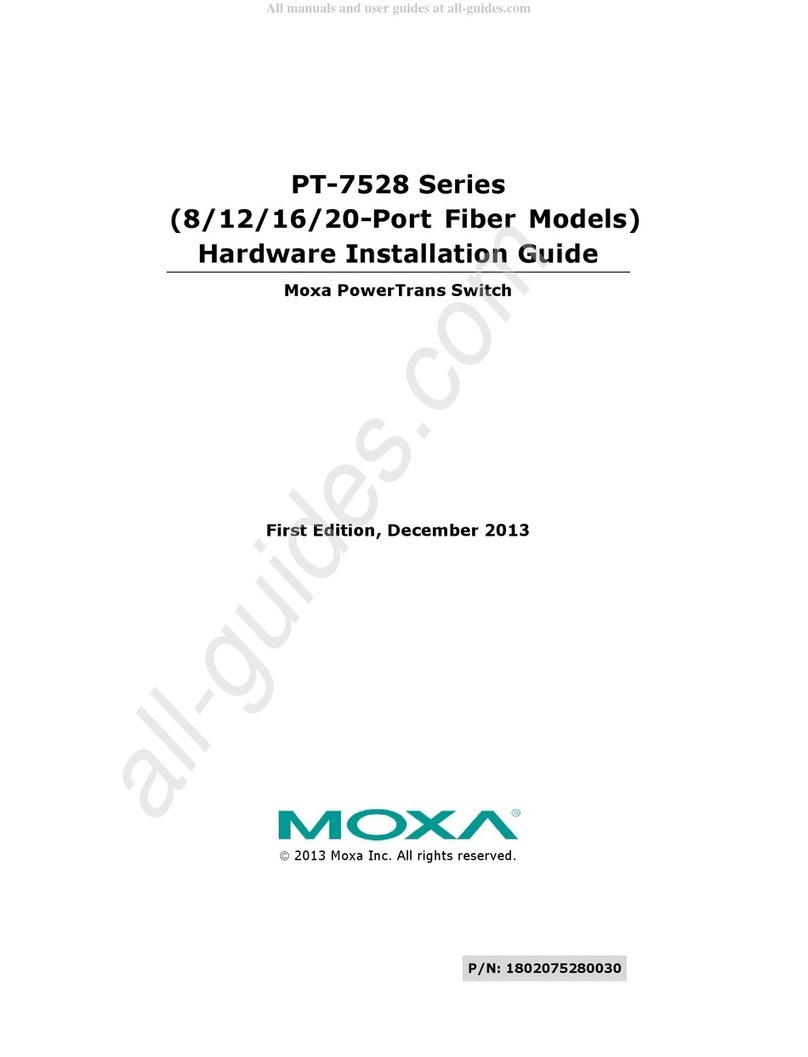
Moxa Technologies
Moxa Technologies PT-7528 Hardware installation guide
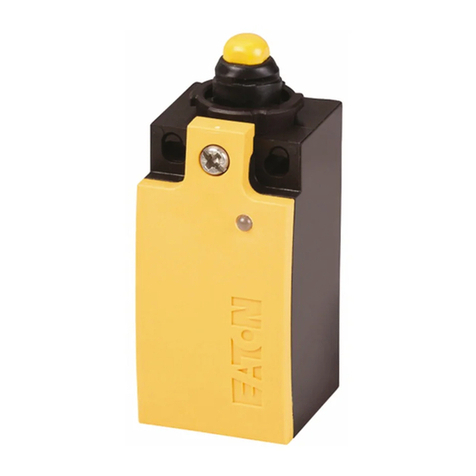
Eaton
Eaton LSE-11 Original operating instructions


